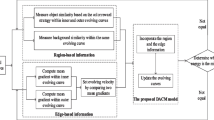Abstract
In this paper, an improved contour-fitting adaptive snake, namely a rectification-conducted adaptive snake (RCA-snake) is proposed for segmenting complex-boundary objects from the textured background. Based on the snaxels’ initialization, the RCA-snake comprises two steps. Initially, edge-conducted evolution (ECE) is employed for adaptations of model coefficients that accommodate ECE itself to the characteristics of salient edges for enhancing curve fitting in tracking. Following ECE, direction-induced rectification evolution corrects the boundary-unmatched snake fragments by handling the initializations of their snake-force direction and tensile-force weighting. The two steps of the RCA-snake are coordinated to enhance control of the snake model for segmenting an object with high-curvature boundaries. Simulation results demonstrate that better object-boundary coincidence can be obtained via the RCA-snake than other snake models, such as the gradient vector flow (GVF) and improved GVF, e.g., NGVF, in segmenting a complex-boundary object from textured-background images.



Similar content being viewed by others
References
Freedman, D., Zhang, T.: Active contours for tracking distributions. IEEE Trans. Image Process. 13(4), 518–526 (2004)
Neumann, A.: Graphical Gaussian shape models and their application to image segmentation. IEEE Trans. Pattern Anal. Mach. Intell. 25(3), 316–329 (2003)
Tang, J.: A multi-direction GVF snake for the segmentation of skin cancer images. Pattern Recognit. 42(6), 1172–1179 (2009)
Wang, Z., Zheng, Z.: A region based stereo matching algorithm using cooperative optimization. In: Proceedings of International Conference on Computer Vision and Pattern Recognition, pp. 1–8. IEEE (2008).
Kass, M., Witkin, A., Terzopoulos, D.: Snakes: active contour models. Int. J. Comput. Vis. 1, 321–331 (1987)
Cheng, J., Foo, S.W.: Dynamic directional gradient vector flow for snakes. IEEE Trans. Image Process. 15(6), 1563–1571 (2006)
Cohen, L.D.: On active contour models and balloons. Comput. Vis. Graph. Image Underst. 53(2), 211–218 (1991)
Mclnerney, T., Terzopoulos, D.: T-snakes: topology adaptive snakes. Med. Image Anal. 4, 73–90 (2000)
Ning, J., Wu, C., Liu, S., Yang, S.: NGVF: an improved external force field for active contour model. Pattern Recognit. Lett. 28(1), 58–63 (2007)
Xu, C., Prince, J.L.: Snakes, shapes, and gradient vector flow. IEEE Trans. Image Process. 7(3), 359–369 (1998)
Mishra, A., Wong, A.: KPAC: a kernal-based parametric active contour method for fast image segmentation. IEEE Signal Process. Lett. 17(3), 312–315 (2010)
Mishra, A., Fieguth, P.W., Clausi, D.A.: Decoupled active contour (DAC) for boundary detection. IEEE Trans. Pattern Anal. Mach. Intell. 33(2), 310–324 (2011)
Chan, D.Y., Hsu, R.C., Chiu, T.Y., Lin, C.C.: Fast robust object segmentation by progressive shapr-anchor selecting and adaptive-thresholding piecewise linking. Inte. J. Innov. Comput. Inf. Control. 8(10A), 6903–6919 (2012)
Kekre, H.B., Thepade, S.D., Banura, V.K.: Image retrieval using texture patterns generated from walsh-hadamard transform matrix and image bitmaps. Commun. Comput. Inf. Sci. 145(1), 99–106 (2011)
Qian, Z., Metaxas, D.N., Axel, L.: A learning framework for the automatic and accurate segmentation of cardiac tagged MRI images. LNCS. 3765, 93–102 (2005)
Arbelaez, P., Maire, M., Fowlkes, C., Malik, J.: Contour detection and hierarchical image segmentation. IEEE Trans. Pattern Anal. Mach. Intell. 33(5), 898–916 (2011)
Single object segmentation evaluation database. http://www.wisdom.weizmann.ac.il/vision/Seg_Evaluation_DB/1obj/index.html
The Berkeley segmentation dataset and benchmark. http://www.eecs.berkeley.edu/Research/Projects/CS/vision/grouping/segbench/
Rother, C., Kolmogorov, V., Blake, A., Brown, M.: Medical imaging at microsoft research. http://research.microsoft.com/en-us/um/cambridge/projects/visionimagevideoediting/segmentation/grabcut.htm
Alpert, S., Galun, M., Basri, R., Brandt, A.: Image segmentation by probabilistic bottom-up aggregation and cue integration. In: Proceeding of International Conference on Computer Vision and Pattern Recognition, pp. 1–8. IEEE (2007).
Acknowledgments
This work was supported by the National Science Council of Taiwan NSC-100-2221-E-415-014, NSC-100-2221-E-415-016, 101-2221-E-415-019-, 103-2221-E-415-022-, and 103-2622-E-415-002-CC3.
Author information
Authors and Affiliations
Corresponding authors
Appendices
Appendix 1: Dominant parameters decision
To ensure stable performance, factors such as model parameters and thresholds utilized in the RCA-snake should be classified for various image characteristics in the initial user-defined region (e.g., hand-marked rectangular area). Without searching for additional image-classification features to map such factors, the maximal gradient magnitudes (MGMs) of the line-representative pixels (LRPs) and backup LRPs resulting from the outcomes of steps 1–2 in the boundary-point detecting-sifting (BPDS) [13] can herein be reused. The MGMs with pixel values exceeding the average pixel value of all MGMs could be defined as qualified MGMs collected for further exploitation. The mean and the standard deviation of the collected MGMs are mutually normalized and then bound together as an image-characteristic vector denoted as \((m_{MGM}, \sigma _{MGM})\). An image sent for object segmentation will be classified by mapping its \((m_{MGM}, \sigma _{MGM})\) to the nearest image-characteristic vector in the trained codebook via vector quantization. Thus, an image-characteristic vector can map a set of suitable dominant factors such as \(\alpha _{ECE}\)(0)’s and \(\beta _{ECE}\)(0)’s in (12) and (13), respectively, where \(\beta _{ECE}\)(0) expresses the initial rigidity parameter values for ECE for one kind of clustered images. Through diverse training for the collected images featuring various attributes, the corresponding codebook shown in Table 2 can be built.
A noticeable problem in applying a snake is that there are snaxels tenaciously sunk inside the object no matter how powerful the rectification method is. By categorizing the values of used thresholds as in Table 2, the occurrence probability of the aforementioned shortcoming can be decreased to a certain extent.
Appendix 2: Hadamard transform (HT)
The 2-D Hadamard transform (HT) [14] is performed on each antithetic block to obtain the horizontal, vertical, and wide-diagonal normalized energies, which can be respectively computed by
where \(C_{u,v}\) is the HT-coefficient at position \((u, v)\) and the normalized term
Rights and permissions
About this article
Cite this article
Chan, DY., Hsu, R.C., Liu, CT. et al. Rectification-conducted adaptive snake for segmenting complex-boundary objects from textured backgrounds. SIViP 10, 225–234 (2016). https://doi.org/10.1007/s11760-014-0731-7
Received:
Revised:
Accepted:
Published:
Issue Date:
DOI: https://doi.org/10.1007/s11760-014-0731-7




